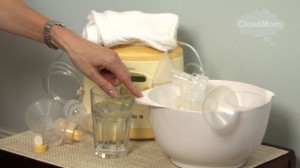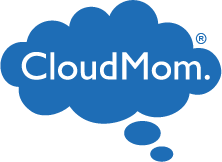Pumping Breast Milk Essentials: Guide and Product Picks
 Everyone talks about how hard breastfeeding can be, but pumping can be even harder, especially if you’re already stressed about returning to work.
Everyone talks about how hard breastfeeding can be, but pumping can be even harder, especially if you’re already stressed about returning to work.
I actually recommend that you begin pumping for five minutes or so after feedings right after you have your baby whether you plan to return to work or not. Pumping like this can help with your milk supply — plus it builds up an emergency freezer stash and allows daddy to give your baby a bottle once in a while, which is nice for him and you!
For the uninitiated, purchasing and assembling a breast pump and all the accompanying equipment can seem like a Herculean task. Breast shields and tubing and valves, oh my! But don’t worry, I’m going to spell it all out for you. Also, make sure to watch my videos about how to assemble and use your pump.
Pump
There is a wide range of options when it comes to choosing a pump and the marketplace is starting to expand from the big players. I recommend you select either a rental hospital grade pump such as the Medela Symphony or a portable double electric pump like the Medela Pump in Style Advanced (aka PISA, which comes with a shoulder bag or backpack). A manual or single electric really isn’t going to cut it for regular use.
I’ve always used the PISA, but I’ve also rented the Medela Symphony from the hospital, which has a lot of UMPH! I’ve stuck with Medela because I have a whole storehouse of pump-related equipment that works across the range of Medela products, and also because I’ve been happy with them generally. Other brands include Ameda and Evenflo, AVENT and Lansinoh.
Includes: Battery pack, plug, one set of tubing, 4 bottles, 2 breast shields with valves and membranes, cooler bag and ice pack.
- Ameda Purely Yours Breast Pump – Carry All
(This is another popular choice among working moms who pump frequently) ($187)
- Medela Symphony Breast Pump (Rent through the hospital, unless you’re looking to shell out over $1,000 – also good to rent because they will replace if there is ever an issue!)
Extra Pump Equipment
4 Breast Shields with Valves and Membranes: I favor pumping after each feed in the early months so I like the extras so you don’t need to wash your stuff all day long. You also want to let your pump parts air dry if possible, which takes time. Breast shields come in different sizes, so consider waiting to see if the standard size that comes with the pump works for you before purchasing more. But ultimately, I recommend getting one if not two extra sets.
- Medela Breast Pump Accessory Set
(4 bottles and caps, 2 breast shields (standard size) with valves and membranes, 2 micro-steam bags) ($22.81)
Tubing: Not a necessity at the beginning, but it’s always good to have a spare set just in case.
Bottles: You need 4-6 extra bottles.
- Medela Value Pack Feeding Gift Set
($17) Includes 3 bottles with slow-flow nipples and caps. You can use these bottles to pump, store and feed. Also includes separate storage bottles and freezer bags.
Emergency Membranes: The membranes are the little white flaps that attach to the yellow valves, and this tiny piece is actually what creates all the suction on the pump. The membranes can tear (and it’s easy to lose them during cleaning — they’re so tiny!) so make sure you have extras on hand beyond the ones you’re using with your spare parts. You should replace the membranes every few months for optimum performance.
- Medela Six Membranes Pack
($6.95)
Cleaning and Sterilizing
Microwave Steam Bags:
These are a great option for sanitizing your pump equipment and bottles.
Quick Clean Wipes:
Milk Storage Bags:
You’ll need these freezer storage bags to begin to freeze the milk that you pump. Check out Medela and Lansinoh, which can hold more milk and are good for down the line when you are pumping higher quantities. Get ballpoint pens or Sharpies to write on these bags.
- Lansinoh Breast Milk Storage Bags, 25-Count Boxes (Pack of 3)
($13.46)
- Medela Pump & Save Breast Milk Bags – 50 Pack
($15.99)
Hands-Free Pumping Bra
This was a life-altering discovery for me. Pumping hands-free is completely liberating because it allows you to actually make a phone call or check emails while you’re pumping – or work! (link show)
- Easy Expression Bustier Hands Free Pumping Bra
($29.80)
- PumpEase Classic Collection Hands-Free Pumping Bra
(Comes in fun patterns!) ($35.00)
One last piece of advice: do not wait until you get home from the hospital to sterilize and assemble the pump parts and see how everything connects. Even if you watch my video tutorial, you will be in a postpartum, sleep-deprived fog and might find it very frustrating. Instead, watch before you have the baby!

